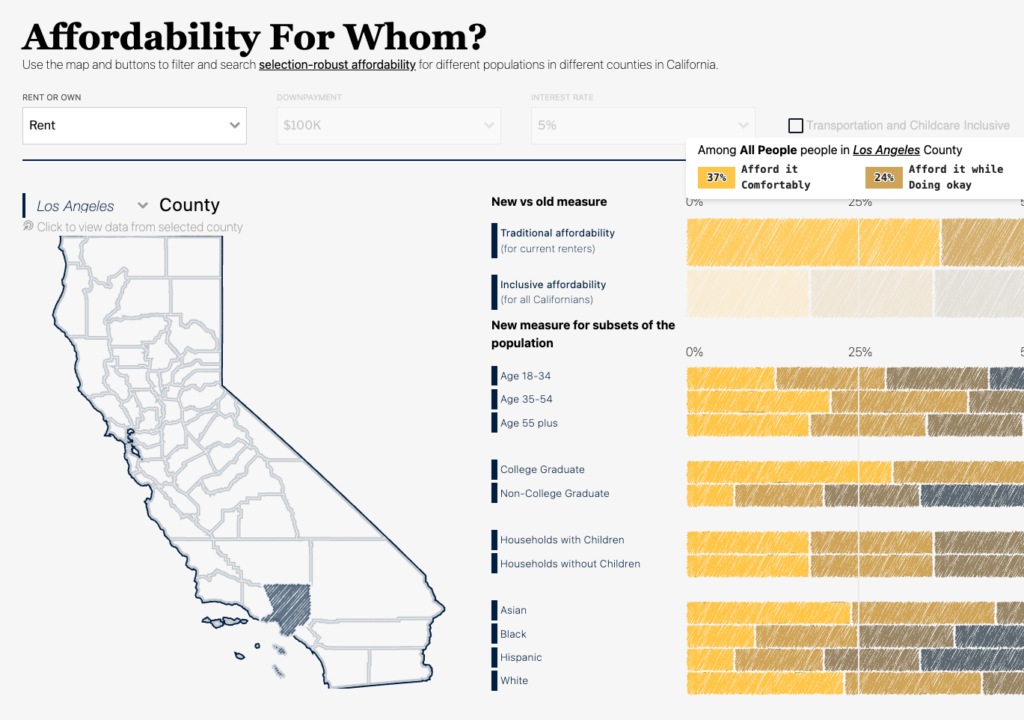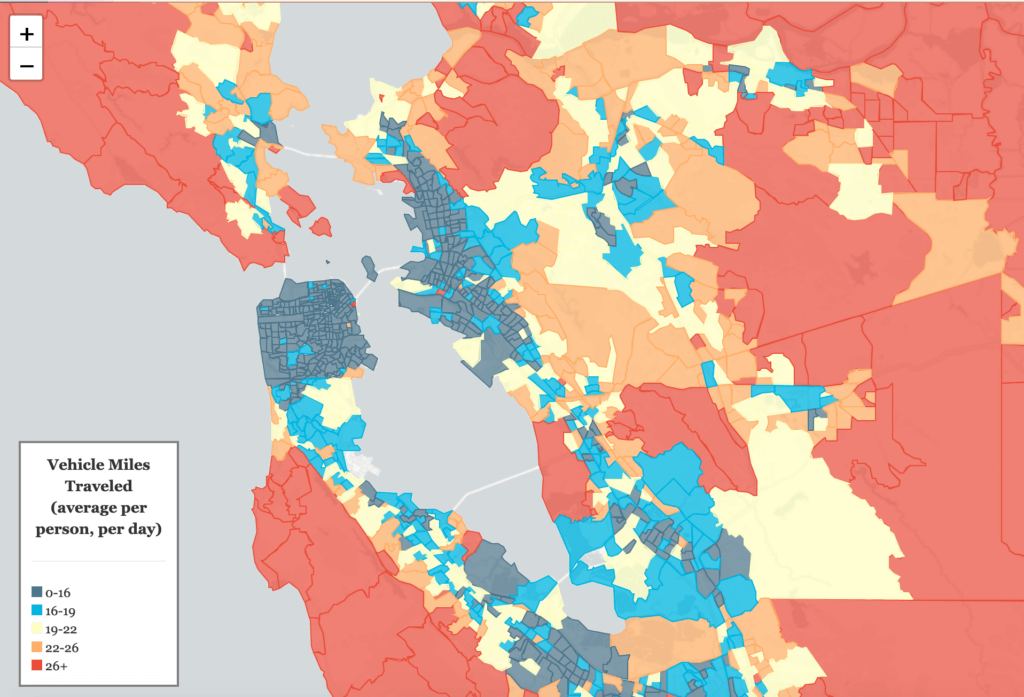Student Capstone Projects
Published On June 23, 2025
As part of our commitment to the education and professional development of UC Berkeley students, the Terner Center highlights exceptional student work that connects to our mission and research agenda. The analyses and policy proposals put forth in these projects may not be reflective of the official position of the Terner Center.
Student Capstone Projects
How We Win Next Time: The Future of Regional Housing Funding in The Bay Area
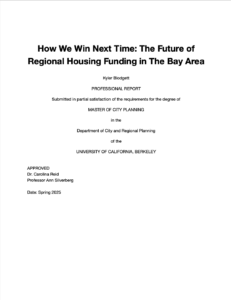 A professional report submitted in partial satisfaction of the requirements for the degree of Master of City Planning in the Department of City and Regional Planning at the University of California, Berkeley; Spring 2025
A professional report submitted in partial satisfaction of the requirements for the degree of Master of City Planning in the Department of City and Regional Planning at the University of California, Berkeley; Spring 2025
Author: Kyler Blodgett, MCRP ’25
Reviewers: Carolina Reid and Ann Silverberg
In June 2024, years of organizing and advocacy culminated in one of the largest bond measures for affordable housing in California’s history being approved for the Bay Area regional ballot. Six weeks later, it was removed. Drawing on interviews with 15 stakeholders, as well as case studies of other voter campaigns for housing funding in California, this report explores the conditions necessary for a similar regional funding effort to succeed in the near future. Coalitional, power-building, and macroeconomic factors are at the heart of the analysis. It also examines several alternative revenue approaches to a general obligation bond for their political viability and revenue potential. This capstone aims to serve as a reference for future regional campaign leaders.
Unpacking the Growth in San Francisco’s Vacant Housing Stock
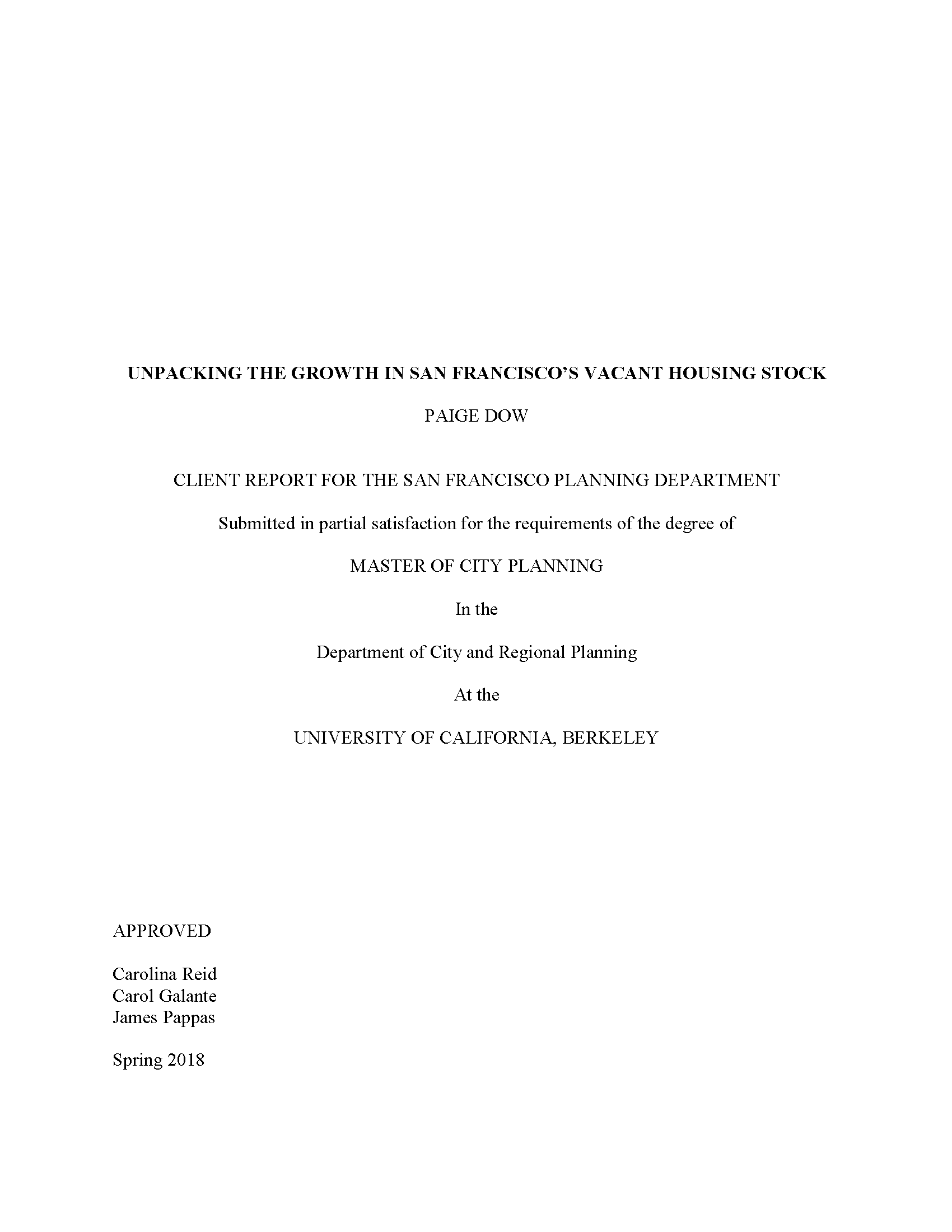 A client report submitted in partial satisfaction of the requirements for the degree of Master of City Planning in the Department of City and Regional Planning of the University of California, Berkeley; May 2018
A client report submitted in partial satisfaction of the requirements for the degree of Master of City Planning in the Department of City and Regional Planning of the University of California, Berkeley; May 2018
Author: Paige Dow
Reviewers: Carolina Reid, Carol Galante, and James Pappas
High vacancy rates typically signal a weak housing market, where supply has outrun demand, and rents have stagnated. However, in San Francisco—as well as in many other high-cost cities such as Vancouver, London, and New York—we see a different phenomenon: an extremely tight housing market with skyrocketing rents, and a puzzlingly high vacancy rate. This report explores the characteristics of San Francisco’s vacant housing stock, as well as the factors contributing to San Francisco’s high vacancy rate. The report analyzes geographic concentrations of vacancy, characteristics of vacant units, and trends in vacancy over time, and presents new qualitative interviews with property managers, property owners, and brokers to try to understand some of the reasons properties may be held off the market. A related blog post is available here.
The End of the Mortgage “Dark Age”: Fintech and the Equity Implications of Disruptive Technology in the U.S. Residential Mortgage Market
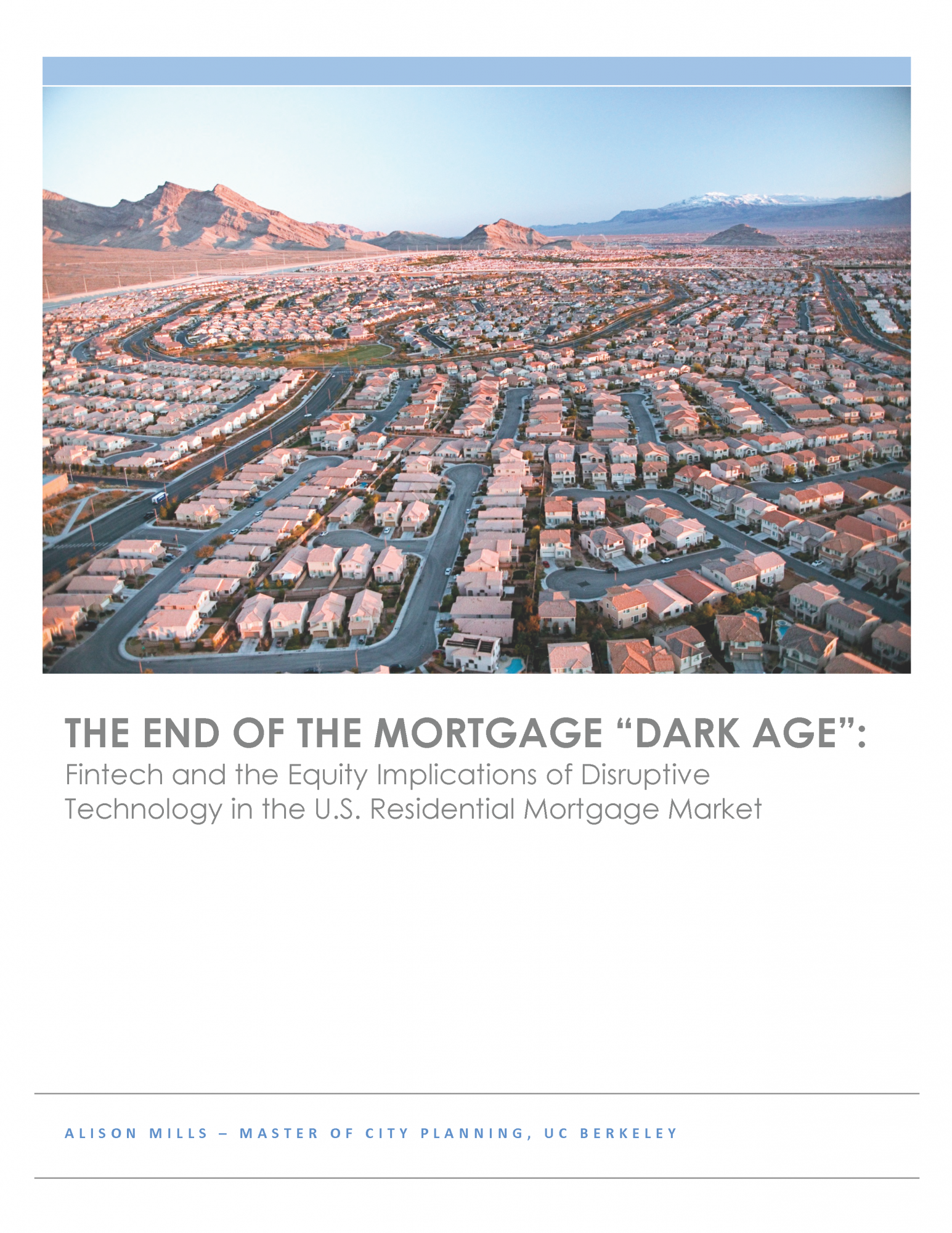 A professional report submitted in partial satisfaction of the requirements for the degree of Master of City Planning in the Department of City and Regional Planning of the University of California, Berkeley; May 2018
A professional report submitted in partial satisfaction of the requirements for the degree of Master of City Planning in the Department of City and Regional Planning of the University of California, Berkeley; May 2018
Author: Alison Mills
Reviewers: Carolina Reid and Carol Galante
Despite the rapid growth in the share of the mortgage market held by financial technology (“fintech”) lenders, the loans originated by fintech companies have not been adequately studied, raising questions about the types of products being offered, the effects of technology on their financing, and ultimately the equitable access to this debt. The report reveals that while fintech improves access to the mortgage application for low-income and minority groups, Black applicants are more likely to be denied by a fintech lender than by a traditional bank. The report also finds that Fintech lenders show significant market penetration in cities that were hit the hardest during the Recession. A related blog post is available here.
Are Tiny Houses Useful and Feasible to Help Address Homelessness in Alameda County? How Could Tiny Homes be Used, and Under What Conditions?
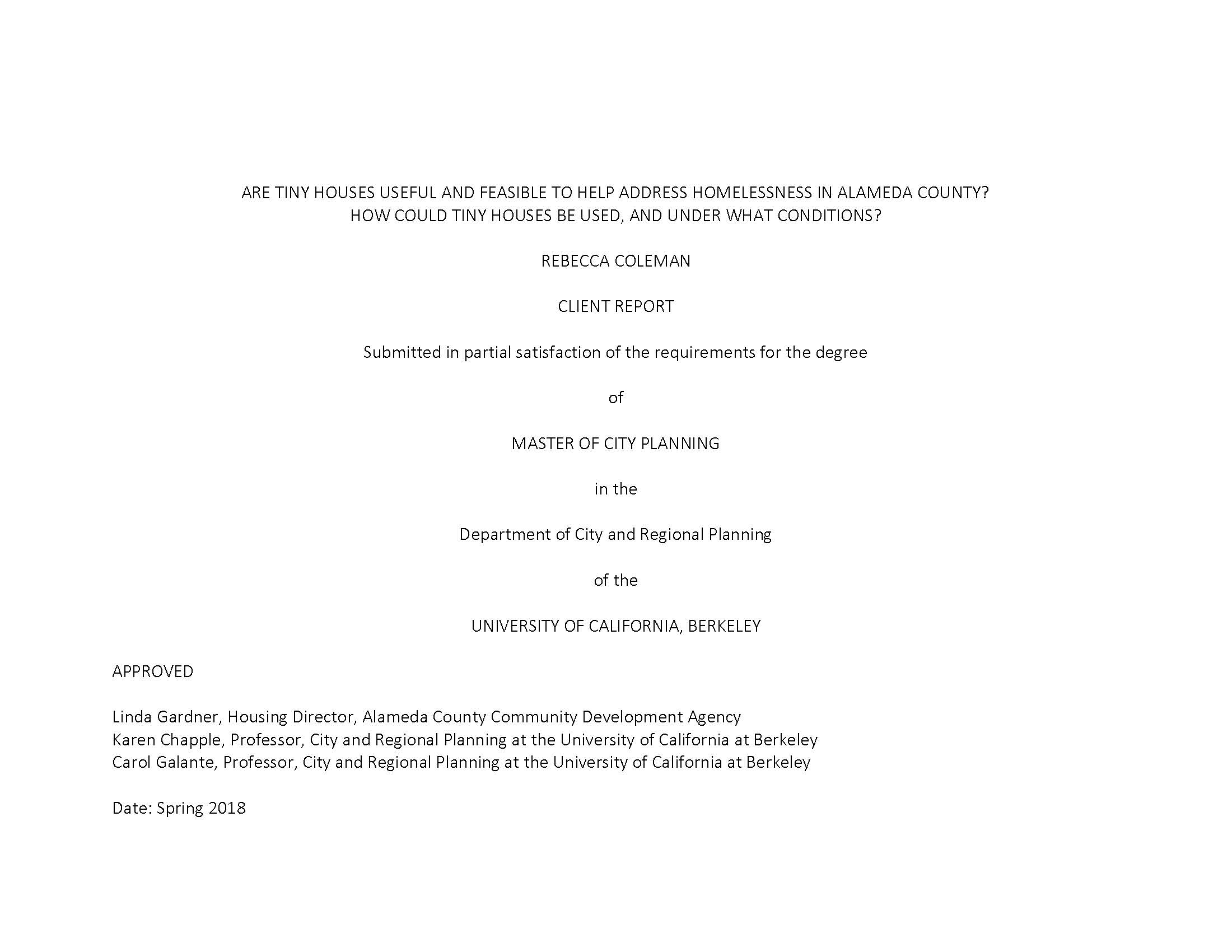 A client report submitted in partial satisfaction of the requirements for the degree of Master of City Planning in the Department of City and Regional Planning of the University of California, Berkeley; May 2018
A client report submitted in partial satisfaction of the requirements for the degree of Master of City Planning in the Department of City and Regional Planning of the University of California, Berkeley; May 2018
Author: Rebecca Coleman
Reviewers: Linda Gardner, Karen Chapple, and Carol Galante
This report explores the application of tiny houses to Alameda County by providing background information about tiny houses for homeless individuals, including a brief history of tiny houses in the U.S. and the contemporary tiny house movement. The report next discusses the tiny house for homeless village model, including components of a successful village, challenges and opportunities for tiny house villages, and recent legislation and trends. Applications of the model are discussed, including micro-apartments, Accessory Dwelling Units (ADUs), and mobile homes. Finally, case studies of tiny house projects that are developed or underway in Oakland, Berkeley, and Hayward are presented. A related blog post is available here.
To Live in the Community You Serve
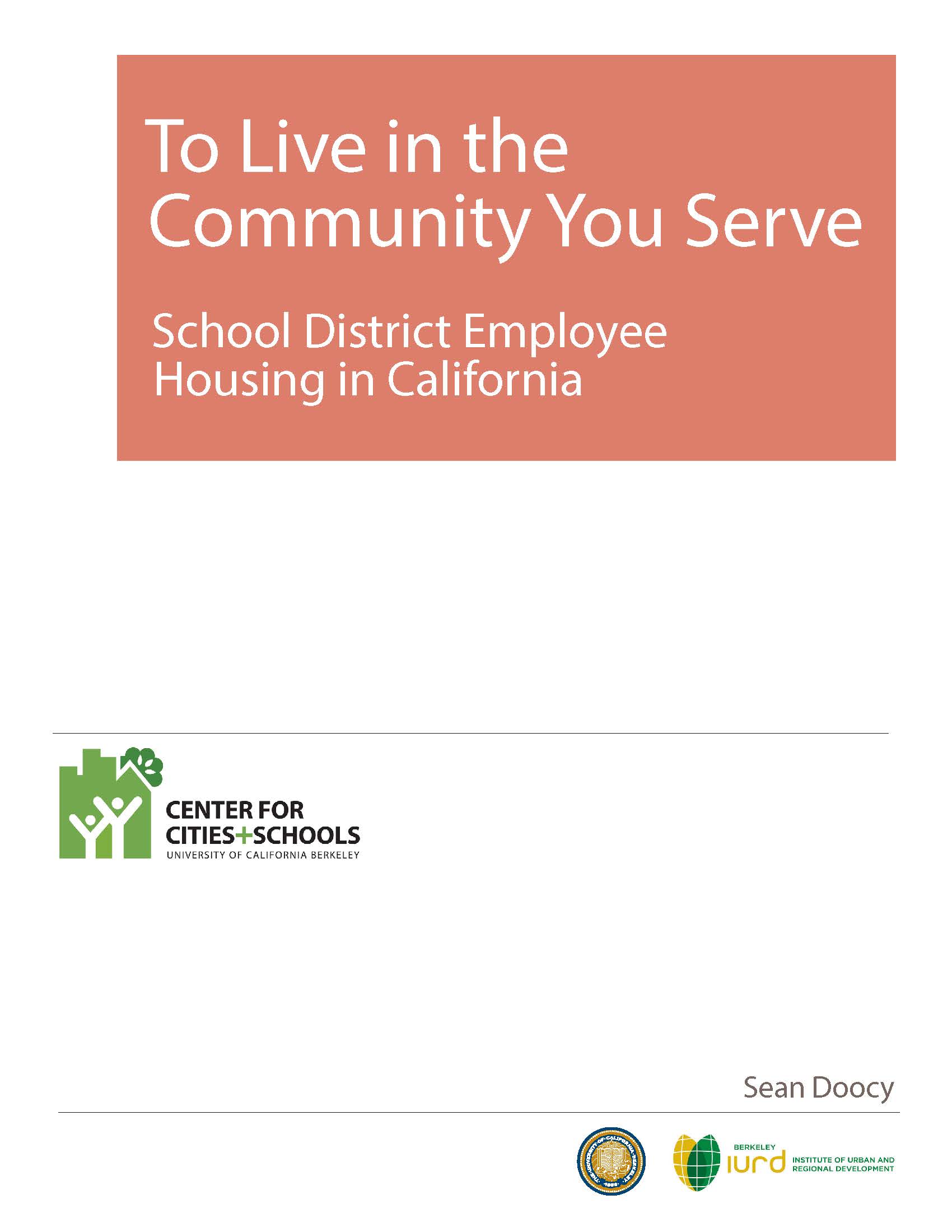 A professional report submitted in partial satisfaction of the requirements for the degree of Master of City Planning in the Department of City and Regional Planning of the University of California, Berkeley; May 2018
A professional report submitted in partial satisfaction of the requirements for the degree of Master of City Planning in the Department of City and Regional Planning of the University of California, Berkeley; May 2018
The research was supported by the Center for Cities + Schools and IURD
Author: Sean Doocy
In recent years in California, school district employee housing has emerged as a strategy for recruiting and retaining teachers and staff. Districts leaders have been asking a series of questions about this new typology: Do employees need or want this rental housing? How do we finance and develop employee housing? What technical hurdles stand in our way? This report helps address those concerns, detailing the current school district employee housing landscape and offering lessons from study of Berkeley Unified School District (BUSD). A related blog post is available here.
Oakland’s Vacant Lots: Encouraging Equitable Development
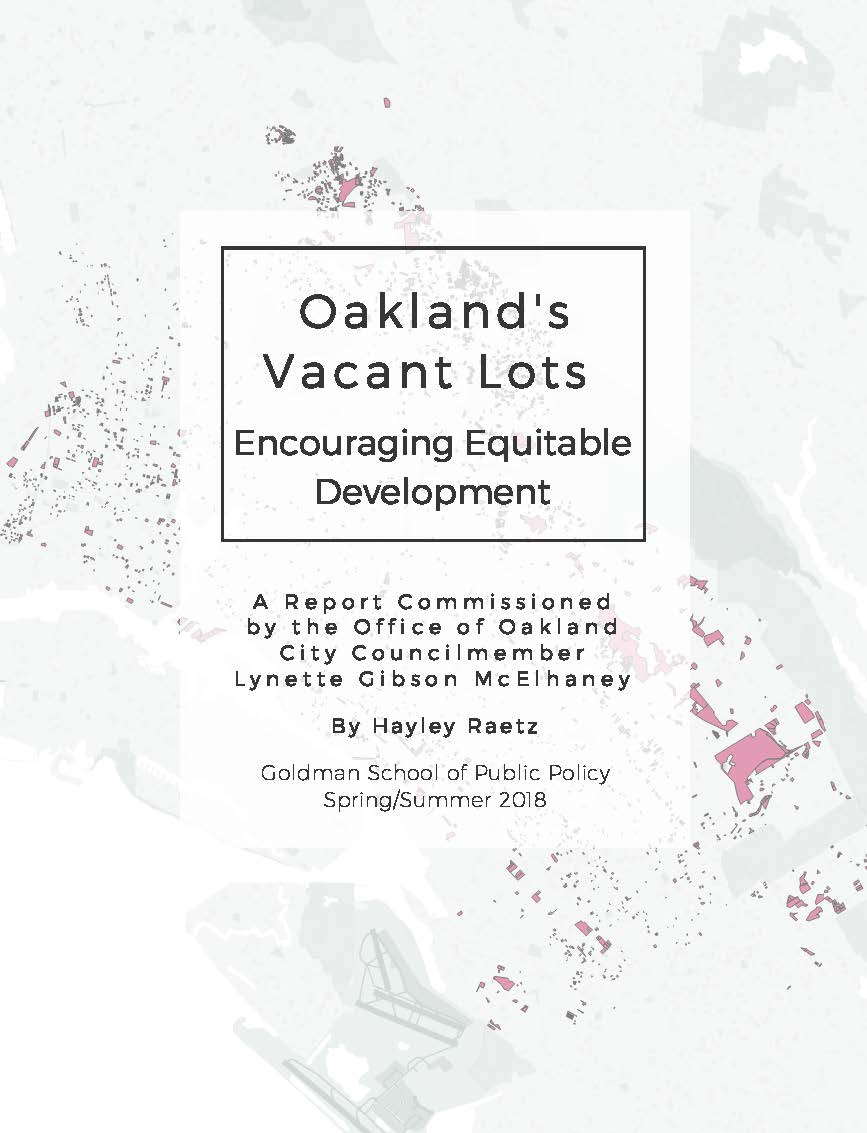 A professional report submitted in partial satisfaction of the requirements for the degree of Master of Public Policy in the Goldman School of Public Policy of the University of California, Berkeley; May 2018
A professional report submitted in partial satisfaction of the requirements for the degree of Master of Public Policy in the Goldman School of Public Policy of the University of California, Berkeley; May 2018
Author: Hayley Raetz
Faculty Advisor: Steven Raphael
As property values skyrocket in Oakland, vacant parcels remain scattered throughout the City’s neighborhoods and industrial areas. In order to define the extent of the problem, this paper uses public and agency data to identify, map, and characterize the vacant parcels in Oakland. This data was then used to analyze two policy approaches to move more parcels into development: one a proposed vacant parcel tax, and the other a program streamlining permitting and lowering impact fees for vacant residential parcels. The author considers the measures’ relative efficiency as well as their impact on equity concerns. A related blog post is available here.
Measuring the Length of the Housing Development Review Process in San Francisco
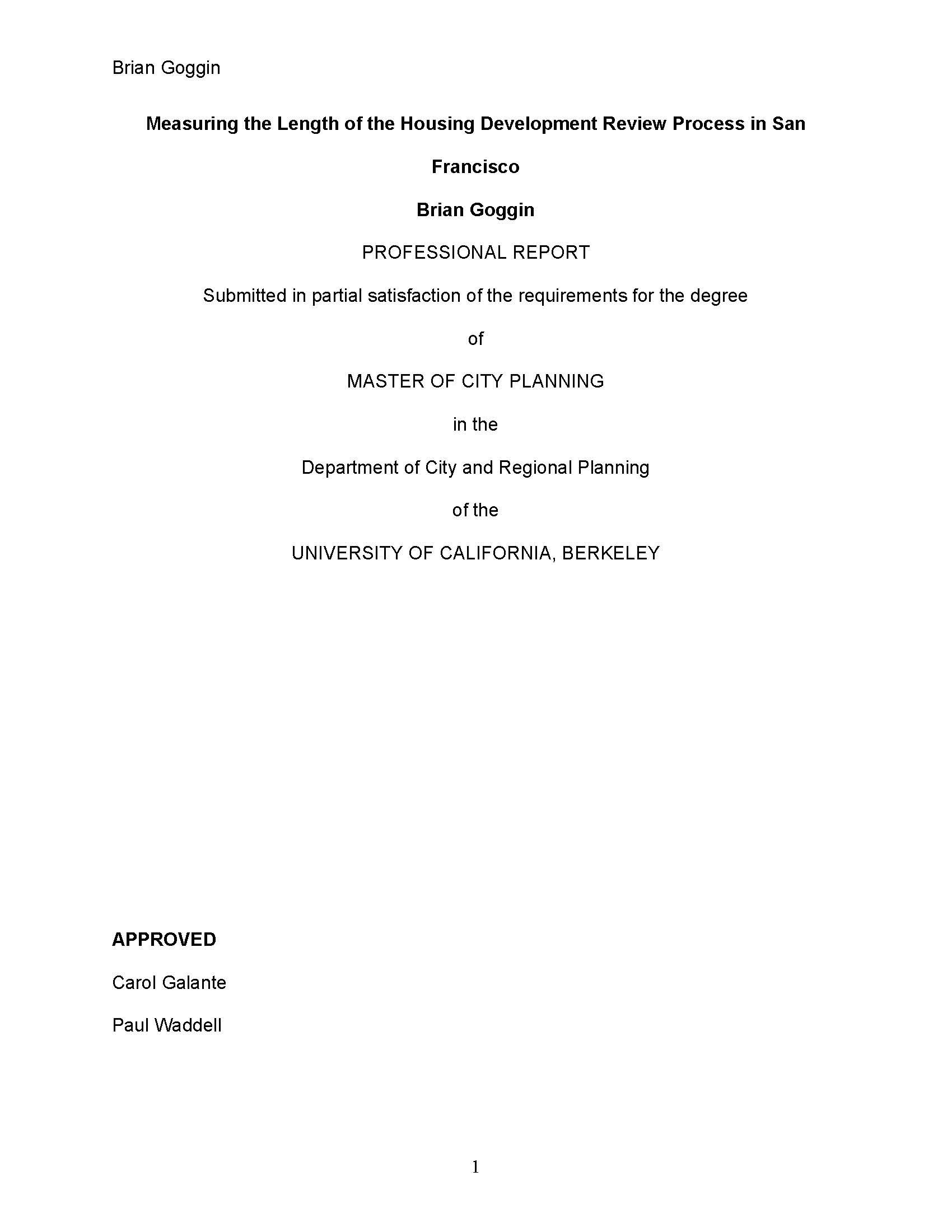 A professional report submitted in partial satisfaction of the requirements for the degree of Master of City Planning in the Department of City and Regional Planning of the University of California, Berkeley; May 2018
A professional report submitted in partial satisfaction of the requirements for the degree of Master of City Planning in the Department of City and Regional Planning of the University of California, Berkeley; May 2018
Author: Brian Goggin
Reviewing Committee: Carol Galante and Paul Waddell
Despite the impacts of the discretionary review process for housing, there is no comprehensive accounting of just how long the process takes. This paper estimates the lengths of various stages of the official permitting review and post-review construction process for a sample of 2,474 housing developments between mid-2009 and early 2017. The results suggest that there is large potential in permit streamlining particularly for mid-sized developments, which are much cheaper to construct and so could have a dramatic impact on the production of affordable housing in the city. A related blog post is available here.
Disruptive Development: Modular Manufacturing in Multifamily Housing
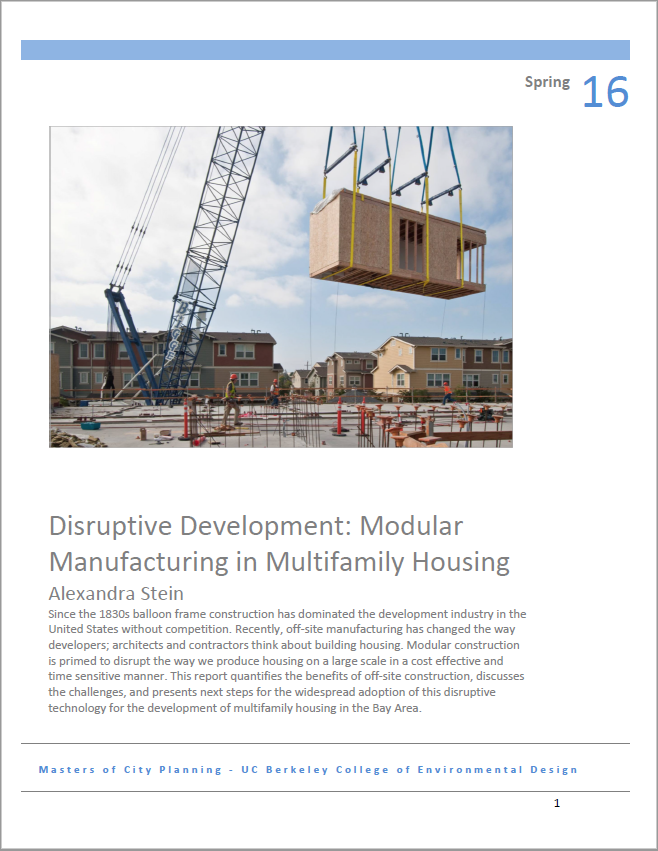 A Professional Report submitted in partial satisfaction of the requirements for the degree of Master of City Planning in the Department of City and Regional Planning of the University of California, Berkeley; May 2016
A Professional Report submitted in partial satisfaction of the requirements for the degree of Master of City Planning in the Department of City and Regional Planning of the University of California, Berkeley; May 2016
Author: Allie Stein
Reviewing Committee: Carolina Reid and Carol Galante
Since the 1830s, balloon frame construction has dominated the development industry in the United States without competition. Recently, off-site manufacturing has changed the way developers; architects and contractors think about building housing. Modular construction is primed to disrupt the way we produce housing on a large scale in a cost effective and time sensitive manner. This report quantifies the benefits of off-site construction, discusses the challenges, and presents next steps for the widespread adoption of this disruptive technology for the development of multifamily housing in the Bay Area.
Other Student Projects
Punitive to Rehabilitative: Strategies for Live-Work Preservation in Oakland
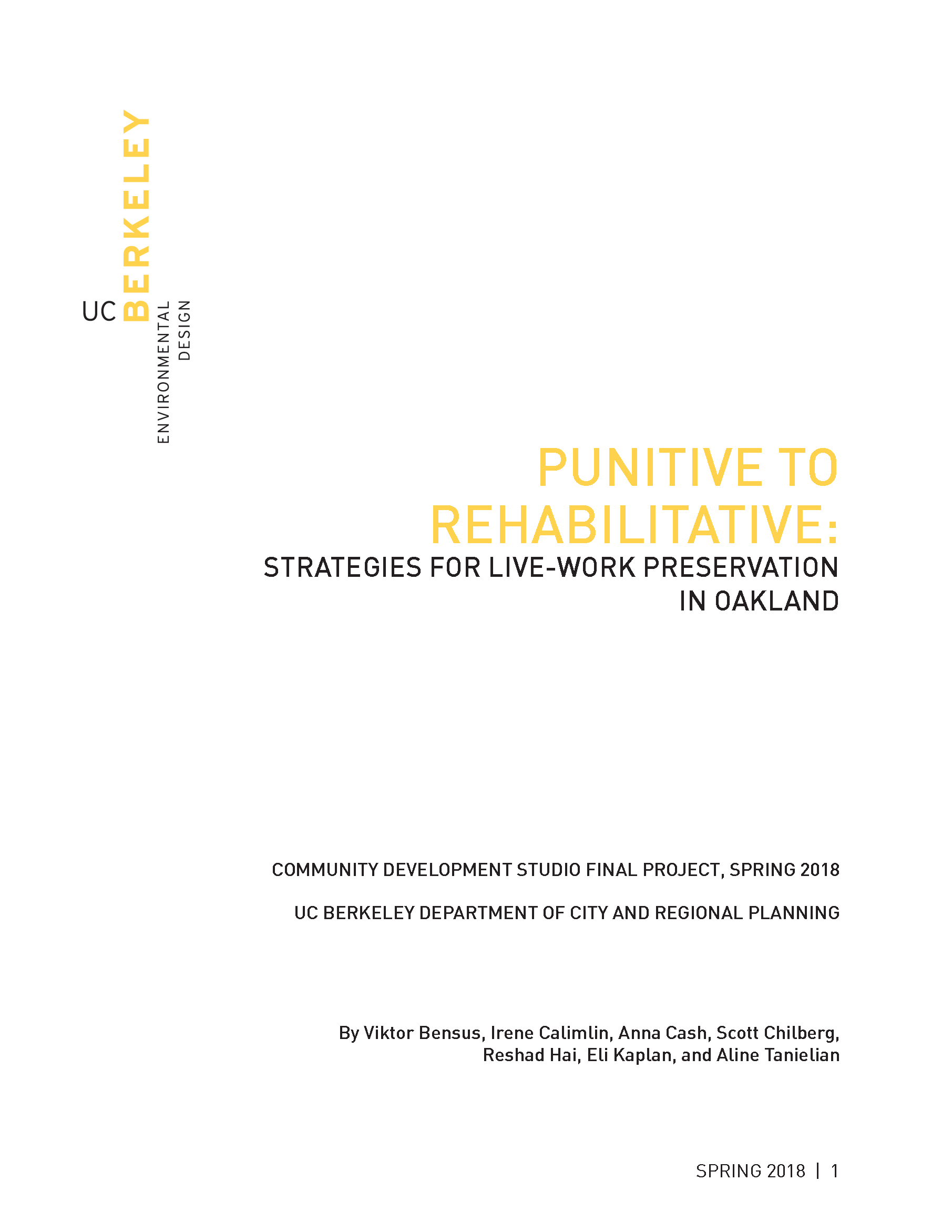 Community Development Studio, Spring 2018
Community Development Studio, Spring 2018
Authors: Viktor Bensus, Irene Calimlin, Anna Cash, Scott Chilberg, Reshad Hai, Eli Kaplan, and Aline Tanielian
On December 2, 2016, thirty-six people died in a fire at the Ghost Ship warehouse space in Oakland, most of whom were there visiting for a show. This tragic loss of life brought to the forefront live-work spaces as an overlooked type of housing in Oakland. While retrospectively the conditions at the Ghost Ship warehouse were exceptionally unsafe, the tragedy raised life-safety questions about other nonconforming spaces, and especially do-it-yourself (DIY) warehouses. While not all spaces represent the same safety risk that Ghost Ship did, there are many steps that can be taken to make these spaces safer without displacing residents.
The Effect of Local Government Policies on Housing Supply
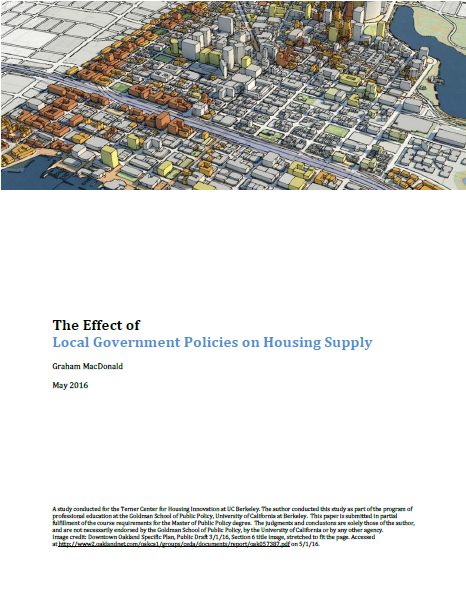 A Housing Development Dashboard study conducted for the Terner Center for Housing Innovation at the University of California, Berkeley; May 2016
A Housing Development Dashboard study conducted for the Terner Center for Housing Innovation at the University of California, Berkeley; May 2016
Author: Graham MacDonald
In consultation with many developers, city planners, politicians, and advocacy groups, the author created two models that summarize the relative impact different local policy measures have on housing production. He then weigh the models’ results against potential equity, administrative, and political concerns. The first model describes the effects on the odds that a given project will be built, while the second examines the cumulative impact on an entire city in four local jurisdictions.
Heartwood Commons: Development Proposal
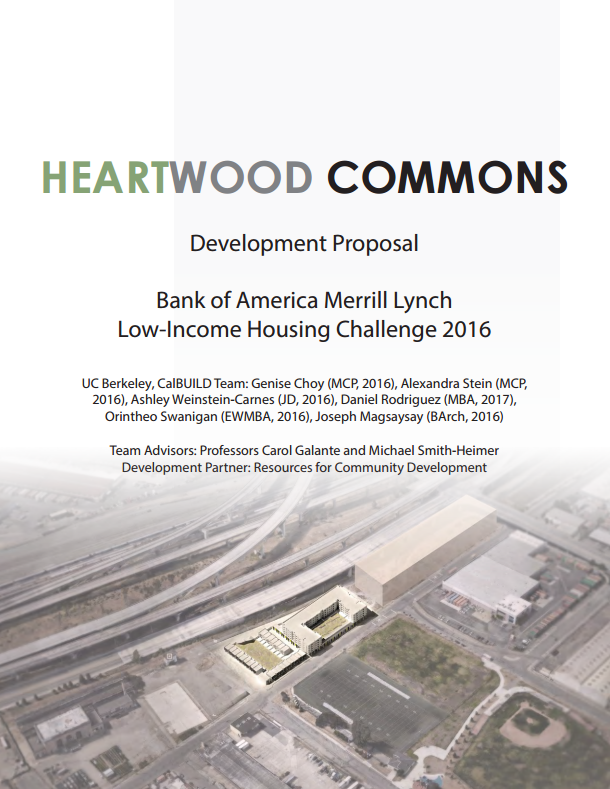 Bank of America Merrill Lynch Low-Income Housing Challenge 2016
Bank of America Merrill Lynch Low-Income Housing Challenge 2016
Authors: UC Berkeley, CalBUILD Team: Genise Choy (MCP, 2016), Alexandra Stein (MCP, 2016), Ashley Weinstein-Carnes (JD, 2016), Daniel Rodriguez (MBA, 2017), Orintheo Swanigan (EWMBA, 2016), Joseph Magsaysay (BArch, 2016)
Team Advisors: Professors Carol Galante and Michael Smith-Heimer
Development Partner: Resources for Community Development
In response to rampantly escalating home prices and rental rates that are sweeping the Bay Area, CalBUILD has partnered with Resources for Community Development (RCD), a well-established affordable housing developer, to bring HEARTWOOD COMMONS, a 145-unit development including 120 new affordable rental and 25 for-sale units, to West Oakland. The project is designed to serve large-family households while also meeting the needs of Oakland’s creative class, which has struggled to retain affordable housing and workspace in the current market, by providing 15 dedicated artist live/work lofts and over 11,000 sq. ft. of programed community art space.




